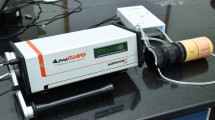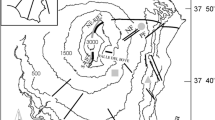Abstract
For nonradioactive geotechnical media, the relationship between effective porosity and known radon concentration varying in sealed chambers was found out theoretically, experimentally as well, based on radon diffusion in the homogeneously porous medium. The radon concentration variation in upper sealed chamber would be linearly affected by the temperature. Furthermore, the effective porosities of certain porous medium models could be calculated by experimental radon concentration with the radon diffusion method. It can be seen that it is feasible to calculate the effective porosity of porous media with no gas pressure difference by the radon diffusion method, by which the primary porosity of geotechnical media will not be destroyed.












Similar content being viewed by others
References
Xiong FS, Gan LD, Sun WT (2021) Characterization of reservoir permeability and analysis of influencing factors in fracture pore media. Chin J Geophys. https://doi.org/10.6038/cjg2021N0175
Wang RC, Li X, Luo Y, Ling HL, Wang B, Liao XJ (2021) Spatial temporal evolution of porosity and leaching migration in in situ acidic leaching of uranium. Nonferrous Metals. https://doi.org/10.3969/j.issn.1007-7545.2021.01.008
Zhang WH, Xue XH (2009) Primary study of permeability of porous media. Rock Soil Mech. https://doi.org/10.3969/j.issn.1000-7598.2009.05.030
Cao Y, Niu GY, Wang TL, Wang YJ (2017) A new method for rock porosity inversion based on in-situ permeability test. Rock Soil Mech. https://doi.org/10.16285/j.rsm.2017.01.034
Zou XY, Chen G, Huang X, Sun SM (2016) Study on radon concentration measurement in soil and its influence factors. Urban Geol. https://doi.org/10.3969/j.issn.1007-1903.2016.03.013
Ai H, Wang ZX, Li M (2014) Application of soil radon survey for uranium exploration in Qijiabuzi area of Lianshanguan. World Nucl Geosci. https://doi.org/10.3969/j.issn.1672-0636.2014.03.008
Li XB, Yao JQ, Yang X (2009) Progress in the research and application of radon gas in ore prospecting. Metal Mine. https://doi.org/10.3321/j.issn:1001-1250.2009.04.001
Pan Y, Liu ZH, Tan KX, Zhang J, Yuan S (2009) Discussion on measurement of eduction rate of niton from uranium Tailing. Morden Mining. https://doi.org/10.3969/j.issn.1674-6082.2009.10.019
Chang ZY, Shi J, Li QH, Zhao HB, Zhou XY (2014) The application of soil radon measurement technology to geothermal exploration in Taxkorgan county, Xinjiang. Geophys Geochem Explor. https://doi.org/10.11720/wtyht.2014.4.05
Ajayi TR, Adepelumi TAA (2002) Reconnaissance soil-gas Radon survey over faulted crystalline area of Ile-Ife, Nigeria. Environ Geol. https://doi.org/10.1007/s002540100428
Hafez YI, Awad E-S (2016) Finite element modeling of radon distribution in natural soils of different geophysical regions. Cogent Phys. https://doi.org/10.1080/23311940.2016.1254859
Sundal AV, Valen V, Soldal O, Strand T (2008) The influence of meteorological parameters on soil radon levels in permeable glacial sediments. Sci Total Environ. https://doi.org/10.1016/j.scitotenv.2007.09.001
Zafrir H, Barbosa SM, Malik U (2013) Differentiation between the effect of temperature and pressure on radon within the subsurface geological media. Radiat Meas. https://doi.org/10.1016/j.radmeas.2012.11.019
Majumder RK, Das SC, Golam Rasul Md, Khalil MI, Dina NT, Kabir MZ, Deeba F, Rajib M (2021) Measurement of radon concentrations and their annual effective doses in soils and rocks of Jaintiapur and its adjacent areas, Sylhet, North-east Bangladesh. J Radioanalyt Nucl Chem. https://doi.org/10.1007/s10967-021-07771-3
Ye YJ, Liu W, Huang CH, Liang T, Feng SY, Chen GL (2020) Radon migration in finite-thickness particle-packing emanation media. J Radioanal Nucl Chem. https://doi.org/10.1007/s10967-020-07095-8
Pan GF, Liu Z, Zhao S, Hu ZQ, Hu XD (2011) Quantitative simulation of sandstone porosity evolution: a case from Yanchang Formation of the Zhenjing area. Ordos Basin Acta Petrolei Sinica 32(02):249–256
Li X, Liu P, Luo YY, Fang CQ, Li B, Wu D (2015) Analysis of influencing factors on porosity measurement of shale gas reservoir core. Prog Geophys. https://doi.org/10.6038/pg20150525
Yang JH, Qin TJ, Yao ML, Yi M (2000) Study on natural Rn method for measuring core porosity. J Southw Petrol Inst 22(03):18–20
Huang Y, Zhang CM (2015) Method for determining porosity by using neutron gamma logging data. J Yangtze Univ. https://doi.org/10.3969/j.issn.1673-1409(s).2015.02.008
He B, Tan XQ, Hong TY, Wang XM (2013) Simplified calculating method of sandstone porosity. Petrol Geol Oilfield Dev Daqing. https://doi.org/10.3969/J.ISSN.1000-3754.2013.06.030
Wang YP, Chen J (2016) Discussion of porosity estimation method with shale volume. World Well Logg Technol 37(06):32–34
Ling ZB, Zou DB, Zhang K, Xu M, Wang J (2011) Investigation on measuring methodology of rock and ore sample porosity. J Jilin Univ. https://doi.org/10.3969/j.issn.1671-5888.2011.03.044
Le RC, Wang XQ (2006) Calculation and measurement of migration coefficient of radon under laboratory conditions. Nucl Sci Tech. https://doi.org/10.1016/S1001-8042(06)60019-5
Li Y, Ye JD, Zhang L, Jiang S, Kong LL (2005) Survey of radon concentrations in bone-coal mining areas and inside BCCB houses in five provinces. Nucl Sci Tech
Morin JP, Seidel JL, Monnin M (1993) A tri-dimensional model for Radon transport in a porous medium. Nucl Tracks Radiat Meas. https://doi.org/10.1016/0969-8078(93)90097-N
Cheng YX, Wang NP, Hou SL (2005) Radiation field and radiation survey. Geological Publishing House, Beijing
Liu JH, Wang ZW, Tian G, Wang XL (2007) Numerical simulation for radon migration in the homogeneous overburden. Chin J Geophys. https://doi.org/10.3321/j.issn:0001-5733.2007.03.034
Neretnieks I (2013) Some aspects of release and transport of gases in deep granitic rocks: possible implications for nuclear waste repositories. Hydrogeol J. https://doi.org/10.1007/s10040-013-0986-z
Zhang W, Zhang DS, Wang XF, Xu MT, Wang HZ (2014) Analysis of mathematical model for migration law of radon in underground multilayer strata. Math Probl Eng. https://doi.org/10.1155/2014/250852
Sun KN, Guo QJ, Cheng JP (2004) A theoretical model on radon exhalation from soil in some regions of China. Chin J Radiat Med Prot. https://doi.org/10.3760/cma.j.issn.0254-5098.2004.06.039
Cheng G, Cheng JP, Guo QJ (2006) Discussion of influencing factors on the radon exhalation rate and theoretical model. Chin J Radiat Med Prot 26(05):520–524
Rogers VC, Nielson KK (1991) Multiphase radon generation and transport in porous materials. Health Phys. https://doi.org/10.1097/00004032-199106000-00006
Zhao W (2010) Rock mechanics. Central South University Press, Changsha
Le RC, He ZJ, Lu Y, Ye QY, Hong JQ, Zhou BY, Chen JD (2010) Measurement of horizontal diffusion coefficient of radon. Nucl Tech 33(3):219–222
Gu HH (2013) Radon diffusion coefficient in different soils and surroundings. Radiat Prot Bull. https://doi.org/10.3969/j.issn.1004-6356.2013.06.008
Acknowledgements
This work was supported by the projects from National Natural Science Foundation of China (No. 41774134), Open Fund of State Key Laboratory of Nuclear Resources and Environment (No. NRE1921), Doctor Start-up Fund of East China University of Technology (No. DHBK2019086) and Jiangxi Key R&D Projects (No. 20171BBG70033). The authors appreciate the technical guidance and help of Miss LIU Yijuan and Mr. ZHANG Xiongjie from East China University of Technology.
Author information
Authors and Affiliations
Corresponding author
Additional information
Publisher's Note
Springer Nature remains neutral with regard to jurisdictional claims in published maps and institutional affiliations.
Rights and permissions
About this article
Cite this article
Luo, Q., Yang, Y., Ning, H. et al. A method for measurement of effective porosity in porous rock and soil media based on radon diffusion. J Radioanal Nucl Chem 331, 391–401 (2022). https://doi.org/10.1007/s10967-021-08072-5
Received:
Accepted:
Published:
Issue Date:
DOI: https://doi.org/10.1007/s10967-021-08072-5




